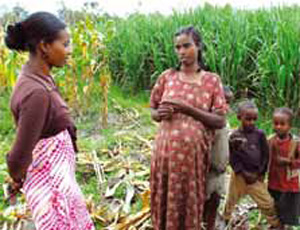2.1.3 Vagina and vulva
The vagina, which was stretched widely to allow the passage of the baby, gradually shrinks to its non-pregnant size and state over a period of about three weeks after the birth. By this date, the increased blood flow and swelling of the vagina and vulva, which was visible immediately after delivery, should have disappeared. Sexual intercourse may resume when the lochia ceases, the vagina and vulva are healed, and the woman is physically comfortable and emotionally ready. Physical readiness usually takes about three to five weeks, but the woman may not feel ready for sexual intercourse for a longer period and she should not be forced to accept it. Your role is to speak gently to her partner to ensure he understands and respects her feelings. In most communities there is a norm for when sexual intercourse starts, which is often after the puerperium ends, at around six weeks from the birth.
Remember that birth control is important to protect against another pregnancy following too soon after the previous birth. The first ovulation is very unpredictable and the woman may get pregnant again even before the return of her first menstrual period.
Birth spacing was discussed in Study Session 14 of the Antenatal Care Module.
What is the benefit of using postnatal family planning to space out the births of more children?
An interval of at least two years between births, and preferably a longer gap, reduces the risk of complications occurring to the mother during the next pregnancy. It also increases the health of the new fetus and the previous infant who may still need it’s mother’s constant care and attention (Figure 2.1).

2.1.2 Cervix
